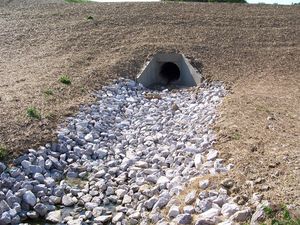
Difference between revisions of "Sediment control practices - Outlet energy dissipation"
| Line 6: | Line 6: | ||
Permanent or temporary energy dissipators prevent erosion, turbulence, and turbidity where stormwater pipes or ditches discharge to unprotected areas, such as channel banks, slopes, or upslope outfall locations. Their main purpose is to reduce the speed of concentrated flows to prevent scour at conveyance outlets. This practice is also called Scour Protection or Outlet Protection. Common types of outlet protection devices include concrete aprons, riprap-lined basins, and settling (stilling) basins. | Permanent or temporary energy dissipators prevent erosion, turbulence, and turbidity where stormwater pipes or ditches discharge to unprotected areas, such as channel banks, slopes, or upslope outfall locations. Their main purpose is to reduce the speed of concentrated flows to prevent scour at conveyance outlets. This practice is also called Scour Protection or Outlet Protection. Common types of outlet protection devices include concrete aprons, riprap-lined basins, and settling (stilling) basins. | ||
| + | |||
| + | [[File:Example of riprap outlet protection.jpg |right|thumb|300 px|alt=This picture shows an example of riprap outlet protection symbol for Stormwater Disconnection in MIDS calculator|<font size=3>Example of riprap outlet protection</font size>]] | ||
Revision as of 16:35, 18 October 2016
This site is currently undergoing revision. For more information, open this link.
This page is under development. We anticipate populating it in autumn, 2016.
This page is under development. We anticipate populating it in autumn, 2016.
Outlet Energy Dissipation (Scour Protection)
Definition
Permanent or temporary energy dissipators prevent erosion, turbulence, and turbidity where stormwater pipes or ditches discharge to unprotected areas, such as channel banks, slopes, or upslope outfall locations. Their main purpose is to reduce the speed of concentrated flows to prevent scour at conveyance outlets. This practice is also called Scour Protection or Outlet Protection. Common types of outlet protection devices include concrete aprons, riprap-lined basins, and settling (stilling) basins.
